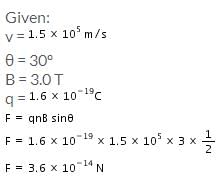All Exams >
MCAT >
MCAT Chemical and Physical Foundations >
All Questions
All questions of Magnetism (PHY) for MCAT Exam
An electron with a speed of 1.8 x 106 m/s is moving in a circular orbit in a uniform magnetic field of 10-4 Wb/m², the radius of the circular path of the electron is
- a)10.63 m
- b)1.063 m
- c)106.3 m
- d)0.1063 m
Correct answer is option 'D'. Can you explain this answer?
An electron with a speed of 1.8 x 106 m/s is moving in a circular orbit in a uniform magnetic field of 10-4 Wb/m², the radius of the circular path of the electron is
a)
10.63 m
b)
1.063 m
c)
106.3 m
d)
0.1063 m

|
Learners Habitat answered |
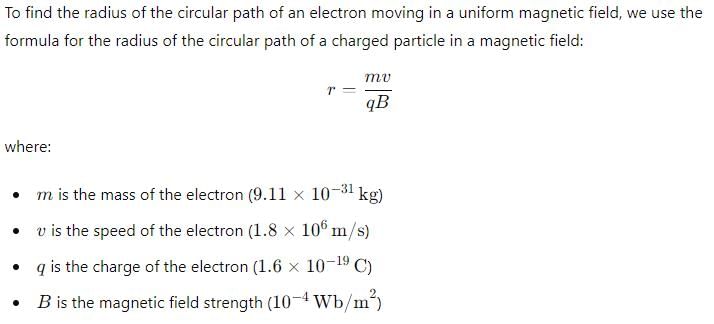
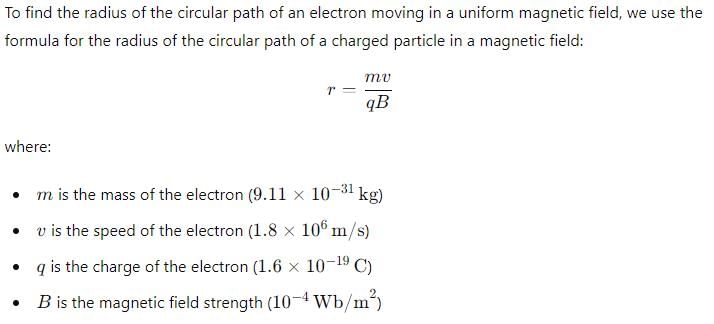
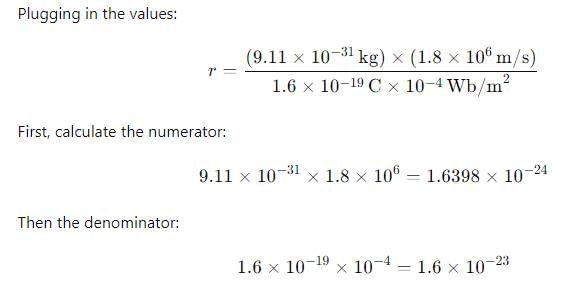
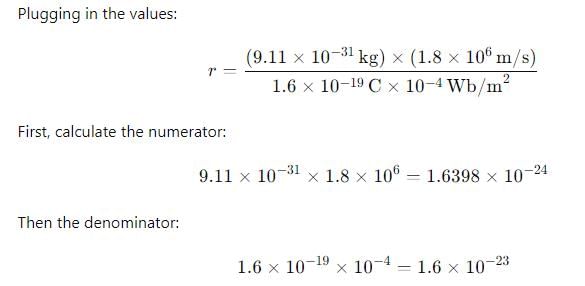
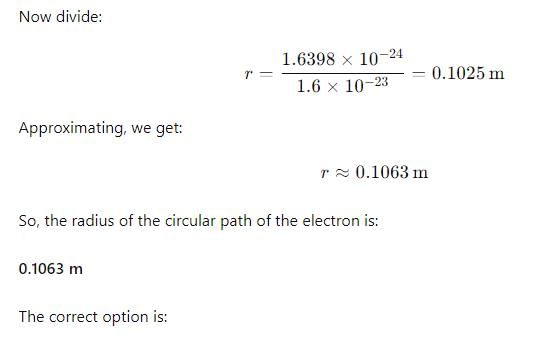
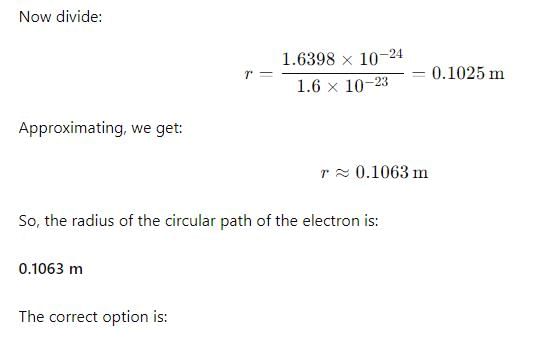
4. 0.1063 m
Which combination of magnetic field lines and poles shows two magnets repelling each other?- a)

- b)

- c)

- d)

Correct answer is option 'B'. Can you explain this answer?
Which combination of magnetic field lines and poles shows two magnets repelling each other?
a)
b)
c)
d)

|
Dr Manju Sen answered |
- The discovery that one particular pole of a magnet orients northward, whereas the other pole orients southward allowed people to identify the north and south poles of any magnet.
- It was then noticed that the north poles of two different magnets repel each other, and likewise for the south poles. Conversely, the north pole of one magnet attracts the south pole of other magnets.
- This situation is analogous to that of electric charge, where like charges repel and unlike charges attract. In magnets, we simply replace the charge with a pole: Like poles repel and unlike poles attract.
A proton with 1MeV kinetic energy is moving in a circular path of radius R in a uniform magnetic field. What should be the energy of an α – particle to describe a circle of same radius in the same magnetic field?- a)2 MeV
- b)0.5 MeV
- c)1 MeV
- d)4 MeV
Correct answer is option 'C'. Can you explain this answer?
A proton with 1MeV kinetic energy is moving in a circular path of radius R in a uniform magnetic field. What should be the energy of an α – particle to describe a circle of same radius in the same magnetic field?
a)
2 MeV
b)
0.5 MeV
c)
1 MeV
d)
4 MeV

|
Shraddha Singh answered |
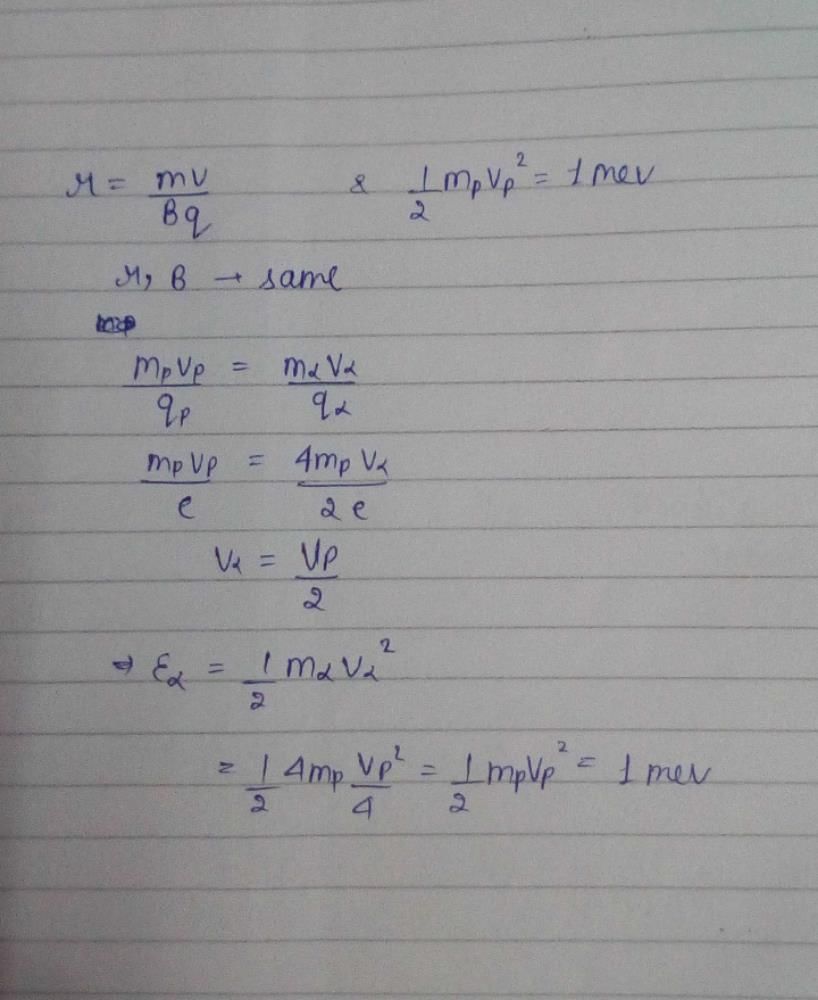
When the switch is closed a magnetic field is produced by the coil. Which answer shows the shape of the field?- a)

- b)
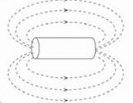
- c)
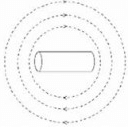
- d)

Correct answer is option 'B'. Can you explain this answer?
When the switch is closed a magnetic field is produced by the coil. Which answer shows the shape of the field?
a)
b)
c)
d)

|
Anand Kumar answered |
Ya it's B ....
Emerges from one side and enter from another side...
Emerges from one side and enter from another side...
The frequency (v) of charged particle, moving at right angles to the magnetic field is independent of- a)radius of circular trajectory (r)
- b)magnetic induction (B)
- c)speed of the particle (v)
- d)both speed of the particle (v) and radius of trajectory (r).
Correct answer is option 'D'. Can you explain this answer?
The frequency (v) of charged particle, moving at right angles to the magnetic field is independent of
a)
radius of circular trajectory (r)
b)
magnetic induction (B)
c)
speed of the particle (v)
d)
both speed of the particle (v) and radius of trajectory (r).

|
Infinity Academy answered |
Frequency (v) = qB/2πm.
Frequency is independent of radius of trajectory of particle and speed of particle.
Frequency is independent of radius of trajectory of particle and speed of particle.
Ratio of magnetic force Fm and electric force Fe acting on a charge getting undeflected through the field is- a)E/B
- b)B/E
- c)1
- d)0
Correct answer is option 'C'. Can you explain this answer?
Ratio of magnetic force Fm and electric force Fe acting on a charge getting undeflected through the field is
a)
E/B
b)
B/E
c)
1
d)
0
|
|
Lavanya Menon answered |
if the particle is undeflected, then the magnetic force equals the electric force:
q x v x B=q x E
B is the magnitude of the magnetic field
E is the magnitude of the electric field
v is the magnitude of the velocity of the particle.
If the forces are equal then:
v=E/B
For undeflected v=1
E/B=1
q x v x B=q x E
B is the magnitude of the magnetic field
E is the magnitude of the electric field
v is the magnitude of the velocity of the particle.
If the forces are equal then:
v=E/B
For undeflected v=1
E/B=1
A particle of charge 1.6 x 10-19 C and mass 1.8 x 10-27 kg is moving around the path of radius 2 x 104 m with velocity 2.4 x 106 m/s. The magnetic field necessary is (in Wb/m²)- a)13.5 x 10-6
- b)135 x 10-6
- c)0.135 x 10
- d)1.35 x 10-6
Correct answer is option 'D'. Can you explain this answer?
A particle of charge 1.6 x 10-19 C and mass 1.8 x 10-27 kg is moving around the path of radius 2 x 104 m with velocity 2.4 x 106 m/s. The magnetic field necessary is (in Wb/m²)
a)
13.5 x 10-6
b)
135 x 10-6
c)
0.135 x 10
d)
1.35 x 10-6
|
|
Sreemoyee Choudhury answered |
Explanation:
When an electron is projected in a uniform electric field and a uniform magnetic field, both pointing in the same direction as the electron's velocity, the following happens:
1. Electric field:
The electric field exerts a force on the electron in the direction of the field. Since the electron is negatively charged, it experiences a force opposite to the direction of the electric field. Therefore, the electric field does not affect the direction of the electron's motion.
2. Magnetic field:
The magnetic field exerts a force on the electron perpendicular to both the field direction and the electron's velocity. The force is given by the Lorentz force equation:
F = q(v x B)
where F is the force, q is the charge of the electron, v is its velocity, and B is the magnetic field.
In this case, the force is directed inward, towards the center of the circular path. The magnitude of the force is given by:
|F| = qvB
where |F| is the magnitude of the force.
Since the force is perpendicular to the velocity, it causes the electron to move in a circular path around the magnetic field lines. The radius of the path is given by:
r = mv/qB
where r is the radius of the path, m is the mass of the electron, and v is its velocity.
3. Combined effect:
Since the electric field does not affect the direction of the electron's motion, the only effect is due to the magnetic field. As the electron moves in a circular path, it loses kinetic energy due to the work done by the magnetic force. Therefore, its velocity decreases in magnitude.
Hence, the correct option is D- The electron velocity will decrease in magnitude.
When an electron is projected in a uniform electric field and a uniform magnetic field, both pointing in the same direction as the electron's velocity, the following happens:
1. Electric field:
The electric field exerts a force on the electron in the direction of the field. Since the electron is negatively charged, it experiences a force opposite to the direction of the electric field. Therefore, the electric field does not affect the direction of the electron's motion.
2. Magnetic field:
The magnetic field exerts a force on the electron perpendicular to both the field direction and the electron's velocity. The force is given by the Lorentz force equation:
F = q(v x B)
where F is the force, q is the charge of the electron, v is its velocity, and B is the magnetic field.
In this case, the force is directed inward, towards the center of the circular path. The magnitude of the force is given by:
|F| = qvB
where |F| is the magnitude of the force.
Since the force is perpendicular to the velocity, it causes the electron to move in a circular path around the magnetic field lines. The radius of the path is given by:
r = mv/qB
where r is the radius of the path, m is the mass of the electron, and v is its velocity.
3. Combined effect:
Since the electric field does not affect the direction of the electron's motion, the only effect is due to the magnetic field. As the electron moves in a circular path, it loses kinetic energy due to the work done by the magnetic force. Therefore, its velocity decreases in magnitude.
Hence, the correct option is D- The electron velocity will decrease in magnitude.
The force acting on a charge q moving with velocity in a magnetic field
in a magnetic field is given by
is given by- a)

- b)

- c)

- d)

Correct answer is option 'C'. Can you explain this answer?
The force acting on a charge q moving with velocity in a magnetic field
in a magnetic field is given by
is given by
a)
b)
c)
d)
|
|
Neha Sharma answered |
The magnetic force on a free moving charge is perpendicular to both the velocity of the charge and the magnetic field with direction given by the right hand rule . The force is given by the charge times the vector product of velocity and magnetic field.
If a charged particle goes undeflected in a region containing electric and magnetic fields. Select all of the following statements that must be true for this.1.  must be perpendicular to
must be perpendicular to
2.  must be perpendicular to
must be perpendicular to
3. E must be perpendicular to u B.
4.  must be perpendicular to
must be perpendicular to
- a)1 and 3 only
- b)1 only
- c)1 and 2 only
- d)2 only
Correct answer is option 'A'. Can you explain this answer?
If a charged particle goes undeflected in a region containing electric and magnetic fields. Select all of the following statements that must be true for this.
1.  must be perpendicular to
must be perpendicular to
2. must be perpendicular to
must be perpendicular to
3. E must be perpendicular to u B.
4. must be perpendicular to
must be perpendicular to
2.
3. E must be perpendicular to u B.
4.
a)
1 and 3 only
b)
1 only
c)
1 and 2 only
d)
2 only
|
|
Lavanya Menon answered |
If a charged particle goes unaccelerated in a region containing
electric and magnetic fields,
electric and magnetic fields,

A Charge is fired through a magnetic field. The magnetic force acting on it is maximum when the angle between the direction of motion and magnetic field is- a)π
- b)zero
- c)π/2
- d)π/4
Correct answer is option 'C'. Can you explain this answer?
A Charge is fired through a magnetic field. The magnetic force acting on it is maximum when the angle between the direction of motion and magnetic field is
a)
π
b)
zero
c)
π/2
d)
π/4
|
|
Krishna Iyer answered |
The force will have a magnitude F=qvB sin q, thus it will be maximum if sin q is maximum. Thus, angle between velocity and magnetic field should be 90o or the charge particle moves perpendicular to the velocity vector.
When a charged particle enters a magnetic field in a direction perpendicular to the field, which one of the following does not change?- a)velocity of the particle.
- b)mass of the particle.
- c)energy of the particle.
- d)momentum of the particle
Correct answer is option 'C'. Can you explain this answer?
When a charged particle enters a magnetic field in a direction perpendicular to the field, which one of the following does not change?
a)
velocity of the particle.
b)
mass of the particle.
c)
energy of the particle.
d)
momentum of the particle
|
|
Geetika Shah answered |
The magnetic force acts perpendicular to the velocity of the particle. This causes circular motion. In the magnetic field the speed and kinetic energy of the particle remain constant, but the direction is altered at each instant by the perpendicular magnetic force.
When a charged particle moves in a magnetic field, its kinetic energy always- a)remain constant
- b)first increases then decreases.
- c)decreases
- d)increases
Correct answer is option 'A'. Can you explain this answer?
When a charged particle moves in a magnetic field, its kinetic energy always
a)
remain constant
b)
first increases then decreases.
c)
decreases
d)
increases
|
|
Rajeev Saxena answered |
The magnetic field does no work, so the kinetic energy and speed of a charged particle in a magnetic field remain constant. The magnetic force, acting perpendicular to the velocity of the particle, will cause circular motion.
Time taken by an ion to describe a semicircular path, in a cyclotron- a)Depends upon the electric field.
- b)depends upon the radius of the circular path.
- c)depends upon speed of ion.
- d)is constant.
Correct answer is option 'D'. Can you explain this answer?
Time taken by an ion to describe a semicircular path, in a cyclotron
a)
Depends upon the electric field.
b)
depends upon the radius of the circular path.
c)
depends upon speed of ion.
d)
is constant.

|
Pragati Dey answered |
As the speed of the ions increases, its mass also increases according to the relation-

Where m0 = the rest mass of the ion
m = the mass of ion while moving with velocity
c = velocity of light.
Now, the time taken by the ion to describe semicircular path is given by

It shows that as v increases, t increases. It means that the positive ion will take longer time to describe semicircular path than the time for half cycle of oscillating electric field. As a result, the ion will not arrive in the gap between the two dees exactly at the instant; the polarity of the two dees is reversed and hence will not be accelerated further.
Two straight horizontal parallel wires are carrying the same current in same direction, d is the distnace between the wires. You are povided with a small freely suspended magnetic needle. At which of the following positions will the orientation of the needle be independent of the magnitude of current in the wires?- a)At a distance d/2 from any of the wires.
- b)At a distance d/2 from any of the wires in the horizontal plane.
- c)Anywhere on the circumference of a vertical circle of radius d ans centre half way between the wires.
- d)At points half way between the wires in the horizontal plane.
Correct answer is option 'A'. Can you explain this answer?
Two straight horizontal parallel wires are carrying the same current in same direction, d is the distnace between the wires. You are povided with a small freely suspended magnetic needle. At which of the following positions will the orientation of the needle be independent of the magnitude of current in the wires?
a)
At a distance d/2 from any of the wires.
b)
At a distance d/2 from any of the wires in the horizontal plane.
c)
Anywhere on the circumference of a vertical circle of radius d ans centre half way between the wires.
d)
At points half way between the wires in the horizontal plane.
|
|
Nandini Patel answered |
The answer is d.
At these points, the resultant field =0
At these points, the resultant field =0
Which one of the Maxwell’s laws leads to the conclusion that there are no magnetic field loops that are not closed?- a)Faraday’s law
- b)Gauss’ law for magnetism
- c)Gauss’ law for electricity
- d)Ampere-Maxwell law
Correct answer is option 'B'. Can you explain this answer?
Which one of the Maxwell’s laws leads to the conclusion that there are no magnetic field loops that are not closed?
a)
Faraday’s law
b)
Gauss’ law for magnetism
c)
Gauss’ law for electricity
d)
Ampere-Maxwell law
|
|
Jyoti Kapoor answered |
In physics, Gauss's law for magnetism is one of the four Maxwell's equations that underlie classical electrodynamics. It states that the magnetic field B has divergence equal to zero,in other words, that it is a solenoidal vector field. It is equivalent to the statement that magnetic monopoles do not exist.Rather than "magnetic charges", the basic entity for magnetism is the magnetic dipole. (If monopoles were ever found, the law would have to be modified, as elaborated below.)
Gauss's law for magnetism can be written in two forms, a differential form and an integral form. These forms are equivalent due to the divergence theorem.
The name "Gauss's law for magnetism"is not universally used. The law is also called "Absence of free magnetic poles";one reference even explicitly says the law has "no name".It is also referred to as the "transversality requirement"because for plane waves it requires that the polarization be transverse to the direction of propagation.
How can a magnetic field be produced?- a)Using a permanent magnet
- b)Electric current
- c)Using a temporary magnet
- d)Using a permanent magnet or electric current
Correct answer is option 'D'. Can you explain this answer?
How can a magnetic field be produced?
a)
Using a permanent magnet
b)
Electric current
c)
Using a temporary magnet
d)
Using a permanent magnet or electric current
|
|
Sanaya Kumar answered |
Production of Magnetic Field
Magnetic field can be produced in various ways. The correct answer is option 'D', which states that a magnetic field can be produced using a permanent magnet or electric current. Let's discuss both of these methods in detail.
Using a Permanent Magnet
A permanent magnet is a magnet that retains its magnetic properties even in the absence of an external magnetic field. The magnetic field produced by a permanent magnet is due to the alignment of its atomic dipoles. The magnetic field produced by a permanent magnet is static and does not change in strength or direction over time.
Using an Electric Current
An electric current is a flow of electric charge through a conductor. When an electric current flows through a conductor, it produces a magnetic field around the conductor. The strength and direction of the magnetic field depend on the strength and direction of the current flowing through the conductor. The magnetic field produced by an electric current is dynamic and can change in strength and direction over time.
Conclusion
In conclusion, a magnetic field can be produced using a permanent magnet or electric current. While the magnetic field produced by a permanent magnet is static, the magnetic field produced by an electric current is dynamic and can change in strength and direction over time.
Magnetic field can be produced in various ways. The correct answer is option 'D', which states that a magnetic field can be produced using a permanent magnet or electric current. Let's discuss both of these methods in detail.
Using a Permanent Magnet
A permanent magnet is a magnet that retains its magnetic properties even in the absence of an external magnetic field. The magnetic field produced by a permanent magnet is due to the alignment of its atomic dipoles. The magnetic field produced by a permanent magnet is static and does not change in strength or direction over time.
Using an Electric Current
An electric current is a flow of electric charge through a conductor. When an electric current flows through a conductor, it produces a magnetic field around the conductor. The strength and direction of the magnetic field depend on the strength and direction of the current flowing through the conductor. The magnetic field produced by an electric current is dynamic and can change in strength and direction over time.
Conclusion
In conclusion, a magnetic field can be produced using a permanent magnet or electric current. While the magnetic field produced by a permanent magnet is static, the magnetic field produced by an electric current is dynamic and can change in strength and direction over time.
Magnetic field strength due to a short bar magnet on its axial line at a distance x is B. What is its value at the same distance on the equatorial line?- a)B/2
- b)B
- c)2B
- d)4B
Correct answer is option 'A'. Can you explain this answer?
Magnetic field strength due to a short bar magnet on its axial line at a distance x is B. What is its value at the same distance on the equatorial line?
a)
B/2
b)
B
c)
2B
d)
4B
|
|
Vivek Rana answered |
The magnetic field at any axial point is given by, B = 2μo/ 4πx3
Similarly, the field at any equatorial point is given by, B = μo/ 4πx3
Thus, the field at any equatorial point is half of what it is at an axial point.
Similarly, the field at any equatorial point is given by, B = μo/ 4πx3
Thus, the field at any equatorial point is half of what it is at an axial point.
Which of the following factors does not affect the strength of the magnetic field produced by a current-carrying wire?- a)Distance from the wire
- b)Current magnitude
- c)Length of the wire
- d)Material of the wire
Correct answer is option 'A'. Can you explain this answer?
Which of the following factors does not affect the strength of the magnetic field produced by a current-carrying wire?
a)
Distance from the wire
b)
Current magnitude
c)
Length of the wire
d)
Material of the wire
|
|
Henry Taylor answered |
Distance from the wire:
Distance from the wire does not affect the strength of the magnetic field produced by a current-carrying wire. The magnetic field strength is determined by the current magnitude, length of the wire, and material of the wire, but not by the distance from the wire. This is because the magnetic field produced by a current-carrying wire follows the inverse square law, meaning that the strength of the magnetic field decreases as you move further away from the wire. However, the distance itself does not directly impact the strength of the magnetic field at a certain point near the wire. It is primarily the current magnitude, length of the wire, and material of the wire that influence the strength of the magnetic field produced.
Distance from the wire does not affect the strength of the magnetic field produced by a current-carrying wire. The magnetic field strength is determined by the current magnitude, length of the wire, and material of the wire, but not by the distance from the wire. This is because the magnetic field produced by a current-carrying wire follows the inverse square law, meaning that the strength of the magnetic field decreases as you move further away from the wire. However, the distance itself does not directly impact the strength of the magnetic field at a certain point near the wire. It is primarily the current magnitude, length of the wire, and material of the wire that influence the strength of the magnetic field produced.
Which of the following statements is true about magnetic domains?- a)Magnetic domains are small, localized regions of a magnet.
- b)Magnetic domains cannot be realigned by an external magnetic field.
- c)Magnetic domains in a magnet are randomly oriented.
- d)Magnetic domains are only found in ferromagnetic materials.
Correct answer is option 'D'. Can you explain this answer?
Which of the following statements is true about magnetic domains?
a)
Magnetic domains are small, localized regions of a magnet.
b)
Magnetic domains cannot be realigned by an external magnetic field.
c)
Magnetic domains in a magnet are randomly oriented.
d)
Magnetic domains are only found in ferromagnetic materials.
|
|
Charles Ross answered |
Overview of Magnetic Domains:
Magnetic domains are regions within a material where the magnetic moments of atoms are aligned in the same direction, resulting in a net magnetic field. These domains play a crucial role in determining the overall magnetic properties of a material.
Explanation of the Correct Statement:
Magnetic domains are only found in ferromagnetic materials:
- This statement is true because magnetic domains are primarily present in ferromagnetic materials. In these materials, the magnetic moments of atoms tend to align in the same direction, creating distinct magnetic domains.
- Ferromagnetic materials exhibit strong magnetic properties due to the presence of aligned magnetic domains, which can be easily reoriented by an external magnetic field.
- Examples of ferromagnetic materials include iron, nickel, and cobalt, which exhibit a high degree of magnetic ordering at the atomic level.
Comparison with Other Materials:
- In contrast to ferromagnetic materials, paramagnetic and diamagnetic materials do not contain well-defined magnetic domains. Paramagnetic materials have magnetic moments that align weakly in the presence of an external magnetic field, while diamagnetic materials exhibit no permanent magnetic moments.
Significance of Magnetic Domains:
- Understanding magnetic domains is essential for various technological applications, including the development of magnetic storage devices, transformers, and magnetic sensors.
- By manipulating the alignment of magnetic domains, researchers can control the magnetic properties of materials for specific purposes, such as data storage or magnetic shielding.
In conclusion, magnetic domains are a critical aspect of the magnetic behavior of ferromagnetic materials, playing a key role in their unique magnetic properties and applications.
Which of the following statements is true regarding magnetic field lines?- a)Magnetic field lines are always closed loops.
- b)Magnetic field lines cannot intersect each other.
- c)Magnetic field lines are more closely spaced in regions of weaker magnetic field.
- d)Magnetic field lines emerge from south poles and enter north poles.
Correct answer is option 'B'. Can you explain this answer?
Which of the following statements is true regarding magnetic field lines?
a)
Magnetic field lines are always closed loops.
b)
Magnetic field lines cannot intersect each other.
c)
Magnetic field lines are more closely spaced in regions of weaker magnetic field.
d)
Magnetic field lines emerge from south poles and enter north poles.
|
|
Ayesha Joshi answered |
Magnetic field lines never intersect each other. If they were to intersect, it would imply that the magnetic field has two different directions at the point of intersection, which is not physically possible. Magnetic field lines are continuous, closed loops and always emerge from the north pole of a magnet and enter the south pole.
Which of the following devices uses the principle of electromagnetic induction?- a)Transformer
- b)Diode
- c)Capacitor
- d)Resistor
Correct answer is option 'A'. Can you explain this answer?
Which of the following devices uses the principle of electromagnetic induction?
a)
Transformer
b)
Diode
c)
Capacitor
d)
Resistor
|
|
Ayesha Joshi answered |
Transformers are devices that utilize electromagnetic induction to transfer electrical energy between two or more circuits. They consist of primary and secondary coils wound around a common iron core. When an alternating current passes through the primary coil, it creates a changing magnetic field, inducing an electromotive force in the secondary coil.
The phenomenon of electromagnetic induction is based on which principle?- a)Ampere's law
- b)Coulomb's law
- c)Faraday's law
- d)Ohm's law
Correct answer is option 'C'. Can you explain this answer?
The phenomenon of electromagnetic induction is based on which principle?
a)
Ampere's law
b)
Coulomb's law
c)
Faraday's law
d)
Ohm's law
|
|
Ayesha Joshi answered |
Electromagnetic induction is the process of generating an electromotive force (emf) or electric current in a conductor by varying the magnetic field around it. This phenomenon is based on Faraday's law of electromagnetic induction, which states that a change in magnetic field induces an electromotive force (emf) in a conductor.
The phenomenon of hysteresis is commonly observed in which magnetic materials?- a)Diamagnetic materials
- b)Paramagnetic materials
- c)Ferromagnetic materials
- d)Non-magnetic materials
Correct answer is option 'C'. Can you explain this answer?
The phenomenon of hysteresis is commonly observed in which magnetic materials?
a)
Diamagnetic materials
b)
Paramagnetic materials
c)
Ferromagnetic materials
d)
Non-magnetic materials
|
|
Ayesha Joshi answered |
Hysteresis is a phenomenon observed in ferromagnetic materials. It refers to the lag or delay in the response of the material's magnetization to changes in the external magnetic field. In ferromagnetic materials, the alignment of magnetic domains can persist even after the external magnetic field is removed, leading to hysteresis loops when the field is cycled. Diamagnetic, paramagnetic, and non-magnetic materials do not exhibit significant hysteresis effects.
The force experienced by a charged particle moving in a magnetic field is maximum when the angle between the velocity of the particle and the magnetic field is:- a)0 degrees
- b)45 degrees
- c)90 degrees
- d)180 degrees
Correct answer is option 'C'. Can you explain this answer?
The force experienced by a charged particle moving in a magnetic field is maximum when the angle between the velocity of the particle and the magnetic field is:
a)
0 degrees
b)
45 degrees
c)
90 degrees
d)
180 degrees
|
|
Ayesha Joshi answered |
The force experienced by a charged particle moving in a magnetic field is maximum when the angle between the velocity of the particle and the magnetic field is 90 degrees. In this case, the force is perpendicular to the velocity, resulting in the maximum deflection of the particle's path.
Which of the following is an example of electromagnetic radiation?- a)Visible light
- b)Sound waves
- c)Ultrasonic waves
- d)X-rays
Correct answer is option 'A'. Can you explain this answer?
Which of the following is an example of electromagnetic radiation?
a)
Visible light
b)
Sound waves
c)
Ultrasonic waves
d)
X-rays
|
|
Ayesha Joshi answered |
Electromagnetic radiation consists of oscillating electric and magnetic fields that propagate through space. Visible light is a form of electromagnetic radiation that can be detected by the human eye. Sound waves and ultrasonic waves are mechanical waves that require a medium for propagation. X-rays, on the other hand, are also a form of electromagnetic radiation, but they are not part of the visible spectrum.
Which of the following statements is true about diamagnetic materials?- a)Diamagnetic materials have permanent magnetic moments.
- b)Diamagnetic materials are attracted to magnets.
- c)Diamagnetic materials have unpaired electrons.
- d)Diamagnetic materials exhibit weak repulsion when placed in a magnetic field.
Correct answer is option 'D'. Can you explain this answer?
Which of the following statements is true about diamagnetic materials?
a)
Diamagnetic materials have permanent magnetic moments.
b)
Diamagnetic materials are attracted to magnets.
c)
Diamagnetic materials have unpaired electrons.
d)
Diamagnetic materials exhibit weak repulsion when placed in a magnetic field.
|
|
Ayesha Joshi answered |
Diamagnetic materials possess no permanent magnetic moments and are weakly repelled by both poles of a magnet. They have all their electron spins paired and do not exhibit magnetic properties like ferromagnetic or paramagnetic materials.
Which of the following statements is true regarding magnetic fields?- a)Magnetic field lines always point from north to south.
- b)Magnetic field lines are always parallel to each other.
- c)Magnetic field lines are only present around magnets.
- d)Magnetic field lines can be used to determine the direction of the magnetic force on a charged particle.
Correct answer is option 'D'. Can you explain this answer?
Which of the following statements is true regarding magnetic fields?
a)
Magnetic field lines always point from north to south.
b)
Magnetic field lines are always parallel to each other.
c)
Magnetic field lines are only present around magnets.
d)
Magnetic field lines can be used to determine the direction of the magnetic force on a charged particle.
|
|
Ayesha Joshi answered |
Magnetic field lines represent the direction of the magnetic field. The force experienced by a charged particle moving in a magnetic field is perpendicular to both the velocity of the particle and the magnetic field lines. By using the right-hand rule, we can determine the direction of the magnetic force on a charged particle.
Chapter doubts & questions for Magnetism (PHY) - MCAT Chemical and Physical Foundations 2025 is part of MCAT exam preparation. The chapters have been prepared according to the MCAT exam syllabus. The Chapter doubts & questions, notes, tests & MCQs are made for MCAT 2025 Exam. Find important definitions, questions, notes, meanings, examples, exercises, MCQs and online tests here.
Chapter doubts & questions of Magnetism (PHY) - MCAT Chemical and Physical Foundations in English & Hindi are available as part of MCAT exam.
Download more important topics, notes, lectures and mock test series for MCAT Exam by signing up for free.
MCAT Chemical and Physical Foundations
336 videos|223 docs|109 tests
|

Contact Support
Our team is online on weekdays between 10 AM - 7 PM
Typical reply within 3 hours
|
Free Exam Preparation
at your Fingertips!
Access Free Study Material - Test Series, Structured Courses, Free Videos & Study Notes and Prepare for Your Exam With Ease

 Join the 10M+ students on EduRev
Join the 10M+ students on EduRev
|

|
Create your account for free
OR
Forgot Password
OR
Signup to see your scores
go up within 7 days!
Access 1000+ FREE Docs, Videos and Tests
Takes less than 10 seconds to signup



